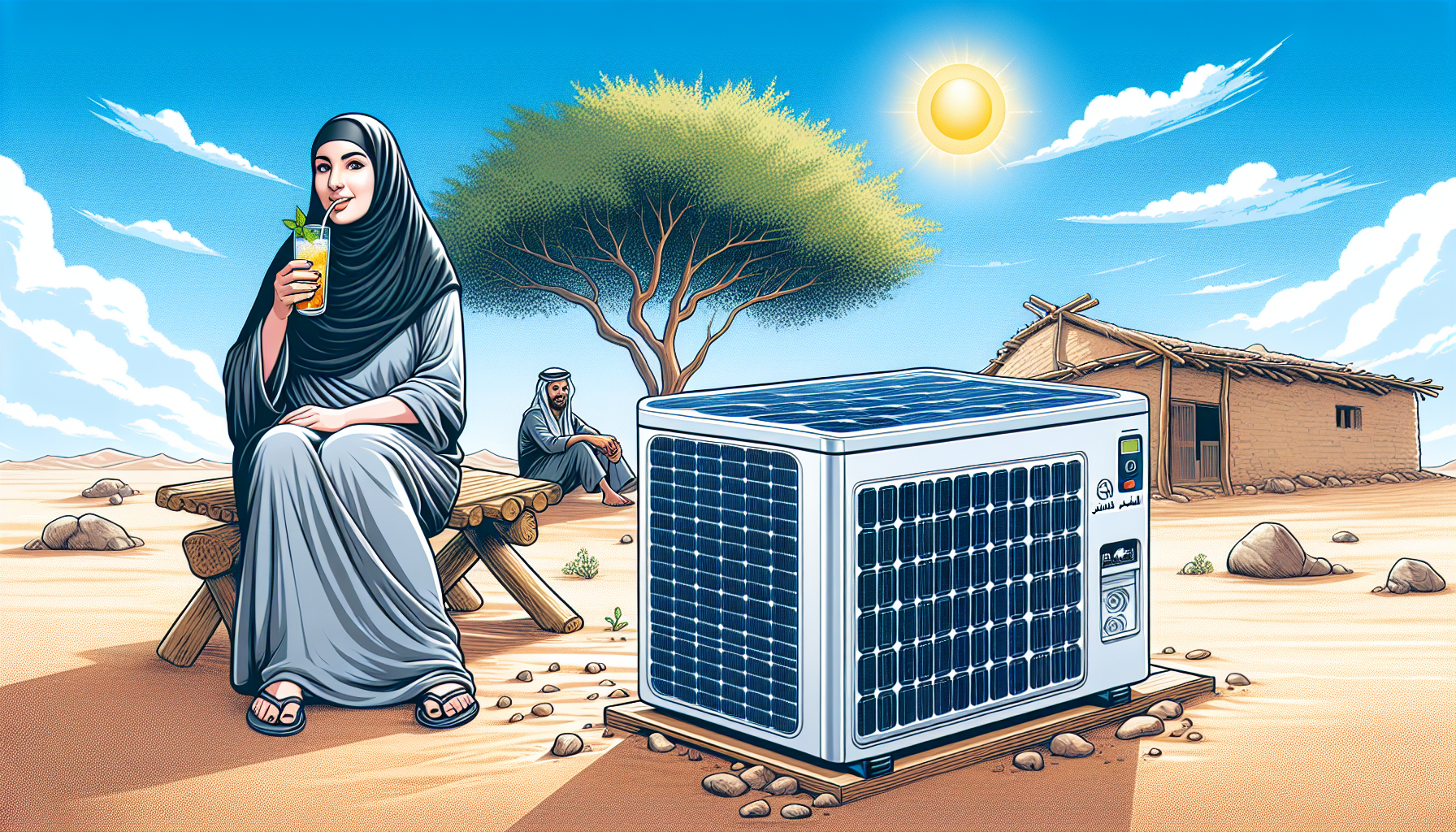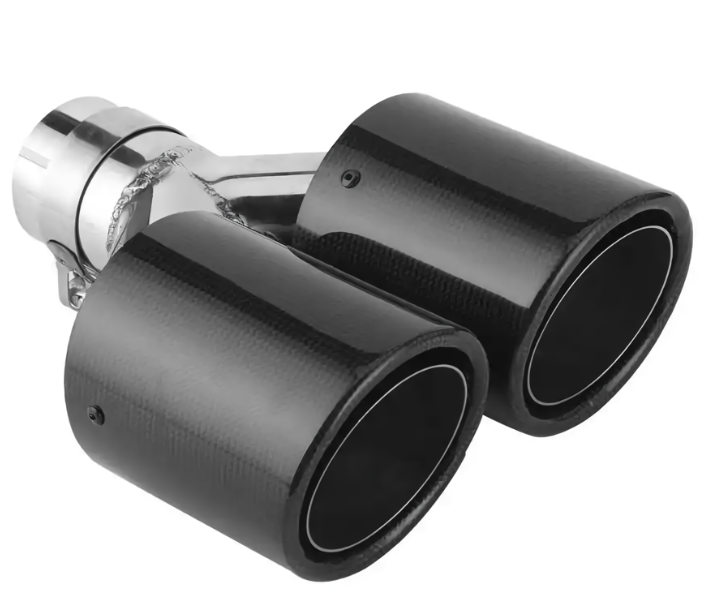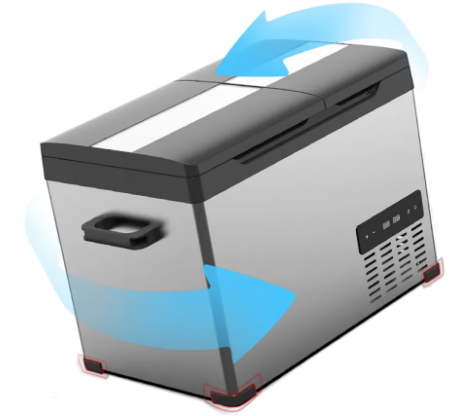Harnessing the Power of the Sun for Eco-Friendly Cooling Solutions

As the world shifts towards a more sustainable future, the synergy between solar energy and portable refrigeration technology has revolutionized the way we live and travel. The CFX3 Series, a line of portable refrigerators, has taken the concept of eco-friendly cooling to new heights. By harnessing the power of solar energy, individuals and communities can now access reliable and efficient cooling solutions, no matter where they are in the world. This article delves into the world of solar charging and the CFX3 Series, exploring the benefits, technological advancements, and real-world applications of this innovative technology.
The evolution of solar power has been a significant factor in the growth of sustainable living. From its humble beginnings to its current widespread adoption, solar energy has become a viable alternative to traditional fossil fuels. By integrating solar panels with the CFX3 Series, users can tap into the power of the sun to keep their food and drinks cool, while reducing their carbon footprint. This technology has opened up new possibilities for outdoor enthusiasts, humanitarian efforts, and off-grid communities, providing a reliable means of cooling in even the most remote locations.
As we explore the benefits of solar-powered cooling, we’ll examine the environmental, practical, and economic advantages of using solar energy for cooling purposes. We’ll also delve into the technical aspects of integrating solar panels with the CFX3 Series, providing a step-by-step guide on setting up your solar-powered cooling system. Whether you’re an avid camper, a humanitarian worker, or simply someone looking to reduce your environmental impact, this article will provide you with the insights and knowledge you need to harness the power of solar energy for your cooling needs.
1. Introduction to Solar Charging and the CFX3 Series

The synergy between solar energy and portable refrigeration technology has revolutionized the way we live and travel. The CFX3 Series, a line of portable refrigerators, is at the forefront of this innovative technology, offering a reliable and efficient means of cooling in even the most remote locations. By harnessing the power of solar energy, individuals and communities can now access sustainable cooling solutions that are environmentally friendly, practical, and cost-effective.
The CFX3 Series is designed to provide users with a seamless and efficient cooling experience. With its advanced technology and design, these portable refrigerators are capable of operating in a wide range of environments, from the harshest desert climates to the most humid tropical regions. The integration of solar panels with the CFX3 Series enables users to tap into the power of the sun, reducing their reliance on traditional fossil fuels and lowering their carbon footprint.
The collaboration of solar energy and portable refrigeration technology has opened up new possibilities for outdoor enthusiasts, humanitarian efforts, and off-grid communities. Whether you’re a camper, a traveler, or a resident of a remote area, the CFX3 Series provides a reliable means of cooling that is both environmentally friendly and cost-effective. In this article, we’ll delve into the benefits, technical advancements, and real-world applications of this innovative technology, exploring the possibilities of solar charging and the CFX3 Series.
The Evolution of Solar Charging
The evolution of solar charging has been a remarkable journey, marked by significant advancements in technology and a growing awareness of the importance of sustainable living. From its humble beginnings in the 1830s, when French physicist Edmond Becquerel discovered the photovoltaic effect, to the modern solar panels that power our homes and devices today, solar energy has come a long way. In the early 20th century, scientists began experimenting with solar panels, but it wasn’t until the 1950s that the first commercial solar panels were developed. These early panels were expensive and inefficient, but they paved the way for the innovations that would follow.
The 1970s and 1980s saw a significant increase in research and development, driven by the oil crisis and growing concerns about climate change. This led to the development of more efficient and cost-effective solar panels, making solar energy a viable alternative to traditional fossil fuels. The 1990s and 2000s saw the widespread adoption of solar power, with governments and companies investing heavily in solar energy infrastructure. Today, solar energy is a major player in the global energy market, with solar panels powering everything from homes and businesses to cars and devices.
The impact of solar charging on sustainable living has been profound. By harnessing the power of the sun, individuals and communities can reduce their reliance on fossil fuels, lowering their carbon footprint and contributing to a cleaner, healthier environment. Solar energy has also enabled the development of off-grid communities, providing energy access to remote areas and promoting energy independence. As the world continues to transition to a more sustainable future, the evolution of solar charging will play a critical role in shaping the path ahead.
Overview of the CFX3 Series
The CFX3 Series is a line of portable refrigerators designed to provide reliable and efficient cooling solutions for individuals and communities on-the-go. Developed with the latest technology and innovative features, these refrigerators are ideal for outdoor enthusiasts, humanitarian workers, and off-grid communities. The CFX3 Series is built to withstand the toughest environments, with a rugged design and robust construction that can withstand extreme temperatures and rough handling.
One of the key benefits of the CFX3 Series is its advanced cooling technology, which provides fast and efficient cooling even in high ambient temperatures. The refrigerators are also equipped with a low-power consumption system, which means they can run for extended periods on a single charge. Additionally, the CFX3 Series features a advanced battery management system, which ensures that the battery is protected from overcharging and deep discharging, prolonging its lifespan.
The CFX3 Series is compatible with a range of power sources, including solar panels, making it the perfect solution for off-grid applications. The refrigerators are also designed to be highly customizable, with a range of accessories and options available to suit specific needs and applications. With its advanced technology, rugged design, and customizable features, the CFX3 Series is the perfect solution for anyone looking for a reliable and efficient portable refrigeration solution.
2. Benefits of Solar-Powered Cooling

The benefits of solar-powered cooling are multifaceted, offering a range of environmental, practical, and economic advantages. One of the most significant benefits is the reduction of greenhouse gas emissions, which contribute to climate change. By harnessing the power of the sun, solar-powered cooling systems reduce our reliance on fossil fuels, decreasing the carbon footprint of cooling operations. Additionally, solar-powered cooling systems are highly efficient, converting a significant amount of the sun’s energy into cooling power, reducing energy waste and increasing overall efficiency.
From a practical perspective, solar-powered cooling systems offer a high degree of flexibility and independence. They can be used in remote areas where traditional energy infrastructure is lacking, providing a reliable means of cooling for communities and individuals. They are also highly durable, with a long lifespan and minimal maintenance requirements, reducing the need for frequent repairs and replacements. Furthermore, solar-powered cooling systems are highly scalable, making them suitable for a wide range of applications, from small-scale cooling needs to large-scale industrial operations.
From an economic perspective, solar-powered cooling systems offer a range of benefits. They reduce energy costs, as the energy generated by the sun is free and abundant. They also reduce the costs associated with maintaining and replacing traditional cooling systems, which can be significant. Furthermore, solar-powered cooling systems can increase property values and improve the overall quality of life, making them a valuable investment for individuals and communities alike.
Reduced Carbon Footprint
One of the most significant benefits of solar-powered cooling is the reduction of greenhouse gas emissions, which contribute to climate change. Traditional cooling systems, such as air conditioners and refrigerators, rely on fossil fuels, which are a major source of carbon emissions. In contrast, solar-powered cooling systems harness the energy of the sun, reducing our reliance on fossil fuels and decreasing the carbon footprint of cooling operations. According to the International Energy Agency (IEA), the use of solar-powered cooling systems can reduce carbon emissions by up to 70% compared to traditional cooling systems.
The reduction of greenhouse gas emissions is critical for mitigating the impacts of climate change. The burning of fossil fuels for cooling and other energy needs releases carbon dioxide, methane, and other gases that contribute to global warming. By transitioning to solar-powered cooling systems, we can reduce the amount of these gases released into the atmosphere, slowing the rate of global warming and its associated impacts, such as sea-level rise, more frequent natural disasters, and changes in weather patterns.
The impact of solar-powered cooling on reducing greenhouse gas emissions is significant. According to the United States Environmental Protection Agency (EPA), the use of solar-powered cooling systems can reduce carbon emissions by up to 1.5 metric tons per year. This is equivalent to the carbon sequestration of up to 35 tree seedlings grown for 10 years. By adopting solar-powered cooling systems, individuals and communities can make a significant contribution to reducing greenhouse gas emissions and mitigating the impacts of climate change.
Energy Independence
Achieving energy independence is a crucial aspect of off-grid living, and solar panels play a vital role in making this a reality. By harnessing the energy of the sun, solar panels can power cooling systems, providing a reliable and sustainable source of energy. This is particularly important for individuals and communities living in remote areas, where access to traditional energy infrastructure may be limited or non-existent. With solar panels, off-grid communities can generate their own energy, reducing their reliance on fossil fuels and mitigating the impact of energy price fluctuations.
Solar panels are an ideal solution for off-grid cooling due to their ability to generate energy consistently, even in remote locations. They can be easily installed and maintained, and their energy output can be tailored to meet specific cooling needs. Additionally, solar panels can be paired with energy storage systems, such as batteries, to provide a stable and reliable source of energy during periods of low sunlight or at night. This ensures that cooling systems remain operational, even when the sun is not shining.
The benefits of energy independence through solar panels are numerous. It enables individuals and communities to live off the grid, reducing their reliance on traditional energy infrastructure and mitigating the impact of energy price fluctuations. It also reduces the carbon footprint of cooling operations, contributing to a more sustainable future. Furthermore, solar panels can provide a sense of security and independence, knowing that energy needs are being met through a reliable and sustainable source. By leveraging solar panels, off-grid communities can achieve energy independence and enjoy the benefits of reliable and sustainable cooling solutions.
3. How Solar Charging Works with the CFX3 Series
The CFX3 Series is designed to seamlessly integrate with solar panels, providing a reliable and efficient means of cooling in off-grid locations. The technical integration of solar panels with CFX3 refrigerators involves a few key components. First, the solar panels are connected to a charge controller, which regulates the flow of energy from the panels to the battery. The battery is then connected to the CFX3 refrigerator, which is designed to operate efficiently on DC power.
The CFX3 Series is optimized for solar charging, with a built-in MPPT (Maximum Power Point Tracking) system that ensures maximum energy harvesting from the solar panels. The system is also designed to prioritize battery charging, ensuring that the battery is fully charged before powering the refrigerator. This ensures that the system is always operating at peak efficiency, minimizing energy waste and reducing the overall cost of ownership.
The CFX3 Series is designed to be highly customizable, with a range of solar panel and battery configurations available to suit specific cooling needs. Whether you’re looking to power a small refrigerator for a camping trip or a large walk-in cooler for a remote community, the CFX3 Series has a solution that can be tailored to meet your needs. With its advanced technical integration and efficient design, the CFX3 Series is the ideal solution for anyone looking to harness the power of the sun for reliable and efficient cooling.
Connecting Solar Panels to CFX3 Refrigerators
Setting up a solar-powered cooling system with CFX3 refrigerators is a straightforward process that can be completed in a few simple steps. First, ensure that you have all the necessary components, including the CFX3 refrigerator, solar panels, charge controller, and battery. Begin by connecting the solar panels to the charge controller, following the manufacturer’s instructions for proper connection and configuration. Next, connect the charge controller to the battery, ensuring that the battery is fully charged before powering the refrigerator.
Once the battery is charged, connect the CFX3 refrigerator to the battery, following the manufacturer’s instructions for proper connection and configuration. Make sure to set the refrigerator to the correct voltage and frequency to ensure optimal performance. Finally, monitor the system to ensure that it is operating efficiently and effectively, making any necessary adjustments to the solar panel angle or configuration to optimize energy harvesting.
It’s important to note that the specific steps and configuration may vary depending on the size and type of solar panel, battery, and CFX3 refrigerator you are using. Always follow the manufacturer’s instructions and take necessary safety precautions when working with electrical systems. With a properly configured and installed solar-powered cooling system, you can enjoy reliable and efficient cooling in even the most remote locations.
Optimizing Solar Energy for Maximum Efficiency
Optimizing solar energy for maximum efficiency is crucial to ensure that your solar-powered cooling system is running at its best. One of the key factors to consider is the angle and orientation of the solar panels. In general, solar panels should be installed at an angle that is equal to the latitude of the location, and facing directly at the sun. However, this may vary depending on the specific environment and location. For example, in areas with high levels of shade or obstruction, it may be necessary to adjust the angle and orientation of the panels to maximize energy harvesting.
Another important factor to consider is the cleanliness of the solar panels. Dirt, dust, and other debris can significantly reduce the efficiency of solar panels, so it’s essential to clean them regularly. In areas with high levels of dust or pollution, it may be necessary to clean the panels more frequently. Additionally, using a high-quality solar panel with a durable and weather-resistant coating can help to minimize the impact of environmental factors on energy harvesting.
Finally, monitoring and adjusting the performance of the solar panels is critical to ensuring maximum efficiency. This can be done using a range of tools and technologies, including solar panel monitoring systems and energy harvesting analytics software. By regularly checking the performance of the solar panels and making adjustments as needed, you can ensure that your solar-powered cooling system is running at its best, even in challenging environmental conditions.
4. Real-World Applications and User Experiences
Solar-powered CFX3 cooling systems are being used in a wide range of real-world applications, from outdoor adventures to humanitarian efforts. One example is in the camping and RV industry, where individuals are using CFX3 refrigerators to keep their food and drinks cold while off the grid. These systems are also being used in remote communities, where access to traditional energy infrastructure is limited. In these communities, solar-powered CFX3 cooling systems are providing a reliable and sustainable means of refrigeration, enabling residents to store food and medicine safely.
In addition to these applications, solar-powered CFX3 cooling systems are also being used in humanitarian efforts around the world. For example, organizations are using these systems to provide refrigeration for vaccine storage and food distribution in areas affected by natural disasters or conflict. The ability to store vaccines and food at the correct temperature is critical in these situations, and solar-powered CFX3 cooling systems are providing a reliable and sustainable means of doing so.
The benefits of solar-powered CFX3 cooling systems are numerous, and users are reporting significant savings in energy costs and a reduction in their carbon footprint. Additionally, these systems are providing a reliable and sustainable means of refrigeration, even in areas with limited access to traditional energy infrastructure. As the demand for sustainable and reliable refrigeration solutions continues to grow, solar-powered CFX3 cooling systems are likely to play an increasingly important role.
Outdoor Adventures
For outdoor enthusiasts, having access to reliable and eco-friendly cooling solutions is a game-changer. Whether you’re a camper, hiker, or traveler, being able to keep your food and drinks cool while on the go is essential. That’s why many are turning to solar-powered CFX3 refrigerators, which provide a sustainable and efficient means of cooling. One camper, Sarah, recently used a CFX3 refrigerator on a week-long camping trip and was thrilled with the results. ‘I was able to keep all my food and drinks cold, even in the hot desert sun,’ she said. ‘And the best part was that I didn’t have to worry about running out of fuel or making a noise disturbance.’
Another user, Mark, used a CFX3 refrigerator on a hiking trip in the mountains. ‘I was able to hike for hours and come back to a cold beer and a fresh meal,’ he said. ‘It was amazing.’ The convenience and peace of mind that comes with having a reliable cooling solution is invaluable for outdoor enthusiasts. With solar-powered CFX3 refrigerators, users can focus on enjoying their outdoor adventure, rather than worrying about their food and drinks.
The benefits of solar-powered CFX3 refrigerators extend beyond just convenience, however. They also offer a sustainable solution for outdoor enthusiasts who want to reduce their environmental impact. By using solar power, users can significantly reduce their carbon footprint and minimize their impact on the environment. Whether you’re a casual camper or a seasoned hiker, solar-powered CFX3 refrigerators are an essential piece of gear for any outdoor adventure.
Humanitarian and off-grid Living
Solar-powered refrigeration is making a significant impact in remote and underserved areas around the world. In these regions, access to reliable and sustainable cooling solutions is crucial for storing food, medicine, and other essential supplies. Solar-powered CFX3 refrigerators are being used in a variety of humanitarian and off-grid living applications, from vaccine storage in rural healthcare clinics to food storage in remote communities. In these areas, traditional energy infrastructure is often limited or non-existent, making solar power the only viable option.
One example of the impact of solar-powered refrigeration is in rural Africa, where a non-profit organization is using CFX3 refrigerators to store vaccines and medicines in remote healthcare clinics. The organization has found that the solar-powered refrigerators are able to maintain a consistent temperature, even in areas with limited access to traditional energy infrastructure. This has resulted in a significant reduction in vaccine spoilage and an increase in the availability of life-saving medicines.
In addition to their use in healthcare, solar-powered CFX3 refrigerators are also being used in off-grid communities to store food and other essential supplies. In these communities, the refrigerators are providing a reliable and sustainable means of refrigeration, enabling residents to store food and reduce their reliance on expensive and polluting diesel generators. By providing access to reliable and sustainable cooling solutions, solar-powered CFX3 refrigerators are making a tangible difference in the lives of people in remote and underserved areas.
5. Choosing the Right Solar Setup for Your CFX3 Cooler
When it comes to selecting the right solar setup for your CFX3 cooler, there are several factors to consider. The first step is to determine your cooling needs, including the size of your cooler and the type of items you plan to store. This will help you determine the required power output of your solar panel. Next, consider your lifestyle and how you plan to use your CFX3 cooler. If you’ll be using it in a fixed location, a stationary solar panel may be sufficient. However, if you’ll be transporting your cooler to different locations, a portable solar panel may be a better option.
Another important consideration is the type of solar panel and accessories you need. Monocrystalline solar panels are a popular choice for off-grid applications due to their high efficiency and durability. Additionally, you may need to consider additional accessories such as a charge controller, battery, and wiring to ensure a safe and efficient system. It’s also important to consider the warranty and customer support offered by the manufacturer, as well as the overall cost of the system.
By considering your cooling needs, lifestyle, and the type of solar panel and accessories required, you can choose the right solar setup for your CFX3 cooler. This will ensure that you have a reliable and efficient system that meets your needs and provides years of trouble-free operation. With the right solar setup, you’ll be able to enjoy the benefits of off-grid cooling while minimizing your environmental impact.
Assessing Your Cooling Requirements
When assessing your cooling requirements, there are several factors to consider in order to determine the size and type of solar panel setup needed. One of the primary considerations is the size of your cooler and the type of items you plan to store. A larger cooler will require a more powerful solar panel setup to maintain the desired temperature, while a smaller cooler may be able to operate effectively with a smaller setup.
Another important factor to consider is the ambient temperature of the environment in which the cooler will be operating. In hot climates, a more powerful solar panel setup may be required to compensate for the increased heat gain. Additionally, the frequency and duration of use should also be taken into account, as a setup that will be used frequently or for extended periods may require a larger solar panel to ensure consistent performance.
Finally, the type of solar panel technology and battery configuration should also be considered. Monocrystalline solar panels are a popular choice for off-grid applications due to their high efficiency and durability, while polycrystalline panels may be a more cost-effective option. The type of battery and charge controller used will also impact the overall performance and efficiency of the system. By carefully considering these factors, you can determine the size and type of solar panel setup required to meet your cooling needs.
Key Features to Look for in Solar Chargers
When selecting a solar charger for your cooling needs, there are several key features to look for to ensure efficient and reliable performance. One of the most important considerations is the efficiency of the solar panel itself. Look for solar panels with a high efficiency rating, typically above 20%, to ensure that you are getting the most power out of your panel. Additionally, consider the durability and weather resistance of the panel, as well as any certifications or warranties that may be offered.
Another important feature to look for is the type of charge controller used in the solar charger. A high-quality charge controller is essential for ensuring that your battery is properly charged and protected from overcharging or deep discharging. Look for a charge controller with advanced features such as maximum power point tracking (MPPT) and low voltage disconnect (LVD) to ensure optimal performance and protection.
Finally, consider the battery type and capacity, as well as any additional features such as USB ports or DC outlets. A high-capacity battery with a long cycle life will provide reliable power for your cooling needs, while additional features such as USB ports can provide added convenience. By considering these key features, you can select a solar charger that meets your needs and provides efficient and reliable cooling performance.
Quiz: Solar Charging and the CFX3 Series
1. What is the primary advantage of using solar energy for cooling? a) Reduced energy costs b) Increased energy independence c) Environmental benefits d) All of the above
2. What is the purpose of a charge controller in a solar charger? a) To generate power from the sun b) To store energy in a battery c) To regulate the flow of energy to a battery d) To convert DC power to AC power
3. What is the benefit of using a CFX3 Series portable refrigerator? a) It is more expensive than traditional refrigerators b) It requires a lot of maintenance c) It provides a reliable and efficient means of cooling off-grid d) It is only suitable for small loads
4. Why is it important to assess your cooling requirements when selecting a solar charger? a) To determine the size of the solar panel needed b) To determine the type of battery required c) To determine the frequency of use d) All of the above
5. What should you look for when selecting a solar charger? a) Low efficiency ratings b) High efficiency ratings c) Low cost d) Aesthetics
1. d) All of the above 2. c) To regulate the flow of energy to a battery 3. c) It provides a reliable and efficient means of cooling off-grid 4. d) All of the above 5. b) High efficiency ratings


